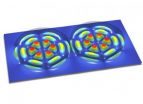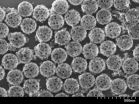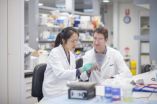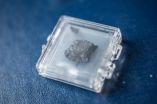(Press-News.org) This news release is available in German.
The cells of the human immune system are created from special stem cells in the bone marrow. In diseases affecting the bone marrow, such as leukemia, the degenerate cells must be destroyed using radiation or chemotherapy. Subsequently, the hematopoietic system has to be replaced with stem cells from the blood of a healthy donor. Because of the resulting temporary weakening of the immune system, patients are more exposed to viruses that would normally be warded off.
The cytomegalovirus (CMV), which can cause serious damage to lungs or liver in persons with a weakened defense, poses a major clinical problem. In healthy human beings, a CMV infection will usually not produce any symptoms, since the virus is kept at bay by specific immune cells. In their work, the scientists were able to demonstrate that the transfer of just a few specific immune cells is sufficient to protect the recipient with the weakened immune system against infections. To do this, they used T cells that can recognize and kill specific pathogens.
Tested in an animal model
Dr. Christian Stemberger, first author of the study, and his colleagues, first isolated T cells from the blood of healthy donor mice. These immune cells were directed against molecular elements of a bacterial species which normally causes severe infections in animals. The T cells were then transferred to recipient mice that, due to a genetic modification, could no longer produce immune cells of their own – similarly to patients suffering from leukemia.
Following the T cell transfer, the researchers infected the treated recipient mice with the bacteria. The results showed that the animals now have effective immune protection against the pathogens, preventing them from becoming ill. "The most astonishing result was that the offspring cells of just one transferred donor cell were enough to completely protect the animals," Christian Stemberger explains.
Successfully used in patients
Finally, the scientists used virus-specific T cells to treat two critically ill patients. Due to a congenital immunodeficiency and leukemia, respectively, stem cell transplants had to be performed on the two patients. Weakened by the procedure, both patients developed CMV infections.
Using a new method, the scientists therefore isolated T cells specifically programmed to target the CMV virus from the blood of the donor and transferred small numbers of these cells to the patients. After only a few weeks, the virus-specific cells proliferated. At the same time, the number of viruses in the blood dropped. "It is a great advantage that even just a few cells can provide protection. This means that the cells can be used for preventive treatment in low doses that are gentler on the organism," Dr. Michael Neuenhahn, last author of the study, explains.
The potential of the identified T cells will now be examined in a clinical study. In addition to an innovative method for cell purification, scientists also have at their disposal a new TUM facility for the sterile manufacture of cell products. In TUMCells, cells can be produced in highly-pure conditions, in so-called clean rooms. In the future, the scientists want to use recent results and TUMCells to develop innovative cell therapies.
INFORMATION:
Original publication:
Christian Stemberger, Patricia Graef, Marcus Odendahl, Julia Albrecht, Georg Dössinger, Florian Anderl, Veit R. Buchholz, Georg Gasteiger, Matthias Schiemann, Götz U. Grigoleit, Friedhelm R. Schuster, Arndt Borkhardt, Birgitta Versluys, Torsten Tonn, Erhard Seifried, Hermann Einsele, Lothar Germeroth, Dirk H. Busch and Michael Neuenhahn, Lowest numbers of primary CD8+ T cells can reconstitute protective immunity upon adoptive immunotherapy, Blood, 2014.
DOI: 10.1182/blood-2013-12-547349
Contact:
Dr. Michael Neuenhahn
Institut für Medizinische Mikrobiologie, Immunologie und Hygiene
Technische Universität München
Trogerstr. 30
81675 Munich
Phone: +49 (0) 89 4140 - 7454
E-mail: michael.neuenhahn@tum.de
Promising T cell therapy
Transfer of a few immune cells can protect immunodeficient patients
2014-06-17
ELSE PRESS RELEASES FROM THIS DATE:
Laser physics upside down
2014-06-17
This news release is available in German.
Sound waves fade, water waves ebb, light waves are dissipated by a wall. The absorption of waves is a very common phenomenon. But only recently have physicists realized that amazing new possibilities are opened up, when this energy loss, rather than being seen as an annoying nuisance, is actually considered a desired effect. At the Vienna University of Technology, a system of two coupled lasers has been created, in which wave dissipation leads to a behaviour completely contrary to intuition: additional energy can switch it ...
Research at Granada finds that the eye's optical quality deteriorates after alcohol consumption
2014-06-17
A study conducted by the University of Granada has scientifically proven that alcohol consumption markedly impairs night-vision because it increases the perception of halos—luminous circles—and other visual night-time disturbances. Moreover, this deterioration of vision is significantly greater in subjects with breath alcohol content in excess of 0.25mg/litre—the legal limit for driving in Spain and other countries and, also, that recommended by the World Health Organization (WHO).
Researchers from the Laboratory of Vision Sciences and Applications conclude that alcohol ...
Does the moon affect our sleep?
2014-06-17
Popular beliefs about the influence of the moon on humans widely exist. Many people report sleeplessness around the time of full moon. In contrast to earlier studies, scientists from the Max Planck Institute of Psychiatry in Munich did not observe any correlation between human sleep and the lunar phases. The researchers analyzed preexisting data of a large cohort of volunteers and their sleep nights. Further identification of mostly unpublished null findings suggests that the conflicting results of previous studies might be due to a publication bias.
For centuries, people ...
How does a tree know it's time to grow again?
2014-06-17
Winter takes its toll on living things. To protect themselves from the elements, bears hibernate, and trees go dormant. Biologists have observed what happens when trees become dormant, but up to now, they haven't understood the underlying genetic mechanisms that enable them to start growing again.
Led by molecular geneticists from Michigan Technological University a gene has been identified and characterized that tells a poplar tree when winter ends and a spring growing season begins. Victor Busov, a professor in Michigan Tech's School of Forest Resources and Environmental ...
Long-term study suggests ways to help children learn language and develop cognitive skills
2014-06-17
Examining factors such as how much children gesture at an early age may make it possible to identify and intervene with very young children at risk for delays in speech and cognitive development, according to a new study by researchers at the University of Chicago.
The research by leading early learning scientists looked at children from a wide variety of backgrounds, including those from advantaged and disadvantaged families, and those who had suffered brain injury. Their work was published in an article, "New Evidence About Language and Cognitive Development Based on ...
Nanoshell shields foreign enzymes used to starve cancer cells from immune system
2014-06-17
Nanoengineers at the University of California, San Diego have developed a nanoshell to protect foreign enzymes used to starve cancer cells as part of chemotherapy. Their work is featured on the June 2014 cover of the journal Nano Letters.
Enzymes are naturally smart machines that are responsible for many complex functions and chemical reactions in biology. However, despite their huge potential, their use in medicine has been limited by the immune system, which is designed to attack foreign intruders. For example, doctors have long relied on an enzyme called asparaginase ...
Gene 'switch' reverses cancer in common childhood leukaemia
2014-06-17
Melbourne researchers have shown a type of leukaemia can be successfully 'reversed' by coaxing the cancer cells back into normal development.
The discovery was made using a model of B-progenitor acute lymphoblastic leukaemia (B-ALL), the most common cancer affecting children.
Researchers from the Walter and Eliza Hall Institute showed that switching off a gene called Pax5 could cause cancer in a model of B-ALL, while restoring its function could 'cure' the disease.
Institute researchers Dr Ross Dickins and Ms Grace Liu led the study with institute colleagues and ...
E-cigs heavily marketed on Twitter, study finds
2014-06-17
E-cigarettes, also known as vaping pens or e-hookas, are commonly advertised on Twitter and the tweets often link to commercial websites promoting e-cig use, according to University of Illinois at Chicago researchers.
The study, published as a special supplement in the July 2014 issue of Tobacco Control released online June 16, has implications for future FDA regulations on the marketing of e-cigarettes and related products.
"There's this whole wild west of social media platforms – Facebook, Twitter and Instagram – and the FDA has no way to track what's happening in ...
Soft-drink tax worth its weight in lost kilos
2014-06-17
A tax on sweetened soft drinks could be an effective weapon in the war against obesity, generating weight losses of up to 3.64 kilograms as individuals reduce their consumption.
Researchers from Monash University, Imperial College London and University of York and Lancaster University, England have estimated the extent to which drinking habits would change if beverages such as carbonated non-diet soft drinks; cordials and fruit drinks were taxed.
Lead author Dr Anurag Sharma, of the Centre for Health Economics at Monash University, said such a tax could have important ...
Solar photons drive water off the moon
2014-06-17
Water is thought to be embedded in the moon's rocks or, if cold enough, "stuck" on their surfaces. It's predominantly found at the poles. But scientists probably won't find it intact on the sunlit side.
New research at the Georgia Institute of Technology indicates that ultraviolet photons emitted by the sun likely cause H2O molecules to either quickly desorb or break apart. The fragments of water may remain on the lunar surface, but the presence of useful amounts of water on the sunward side is not likely.
The Georgia Tech team built an ultra-high vacuum system that ...
LAST 30 PRESS RELEASES:
Norbert Holtkamp appointed director of Fermi National Accelerator Laboratory
New agentic AI platform accelerates advanced optics design
Biologists discover neurons use physical signals — not electricity — to stabilize communication
Researchers discover that a hormone can access the brain by hitchhiking
University of Oklahoma researcher awarded funding to pursue AI-powered material design
Exploring how the visual system recovers following injury
Support for parents with infants at pediatric check-ups leads to better reading and math skills in elementary school
Kids’ behavioral health is a growing share of family health costs
Day & night: Cancer disrupts the brain’s natural rhythm
COVID-19 vaccination significantly reduces risk to pregnant women and baby
The role of vaccination in maternal and perinatal outcomes associated with COVID-19 in pregnancy
Mayo Clinic smartwatch system helps parents shorten and defuse children's severe tantrums early
Behavioral health spending spikes to 40% of all children’s health expenditures, nearly doubling in a decade
Digital cognitive behavioral treatment for generalized anxiety disorder
Expenditures for pediatric behavioral health care over time and estimated family financial burden
Air conditioning in nursing homes and mortality during extreme heat
The Alps to lose a record number of glaciers in the next decade
What makes a good proton conductor?
New science reporting guide published for journalists in Bulgaria
New international study reveals major survival gaps among children with cancer
New science reporting guide published for journalists in Turkey
Scientists develop a smarter mRNA therapy that knows which cells to target
Neuroanatomy-informed brain–machine hybrid intelligence for robust acoustic target detection
Eight SwRI hydrogen projects funded by ENERGYWERX
The Lundquist Institute and its start-up company Vitalex Biosciences Announces Strategic Advancement of Second-Generation fungal Vaccine VXV-01 through Phase 1 Trials under $40 Million Competitive Con
Fine particles in pollution are associated with early signs of autoimmune disease
Review article | Towards a Global Ground-Based Earth Observatory (GGBEO): Leveraging existing systems and networks
Penn and UMich create world’s smallest programmable, autonomous robots
Cleveland researchers launch first major study to address ‘hidden performance killer’ in athletes
To connect across politics, try saying what you oppose
[Press-News.org] Promising T cell therapyTransfer of a few immune cells can protect immunodeficient patients






